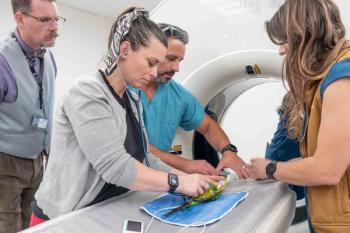
Tweaking your radiograph interpretation for digital radiography-thorax (Proceedings)
Over the last few years digital radiography has become "the purchase" for veterinary clinics and hospitals. While the impetus for the purchase may at first be to keep up with the Jones', those who have made the switch quickly realize the benefits of "going digital".
Over the last few years digital radiography has become "the purchase" for veterinary clinics and hospitals. While the impetus for the purchase may at first be to keep up with the Jones', those who have made the switch quickly realize the benefits of "going digital". However switching to digital does have its downsides but thankfully those downsides are temporary and mostly involve a re-education of the staff and veterinarians.
For veterinarians, correct assessment of a digital radiograph requires letting go of analog film interpretative biases that have developed throughout your career. One of the tough biases to let go of is the tactile response. Most likely veterinarians who made the switch from analog to digital found themselves reaching for the screen at some point as if to hold the screen like a sheet of film. And while this is one of those "duh" moments that makes everyone laugh it points out how ingrained certain habits become through repetition. But don't worry you are not alone. There are several common interpretative over reads associated with the transition from analog to digital. Below is a list of the most common interpretative mistakes when veterinarians switch from analog to digital radiography.
The bronchial pattern
The most difficult interpretative habit to break is over reading a bronchial pattern on a digital radiograph. Due to the inherent improved contrast resolution on digital systems bronchial walls become prominent. Naturally prominent bronchial walls result in the knee jerk reaction of diagnosing chronic bronchitis, particularly in the coughing cat. Typically this "resetting" or recalibration of the bronchial appearance in a normal digital thorax takes approximately 1 month. During that time I would recommend one of three things 1) limit your diagnosis of chronic bronchitis to clinically coughing patients 2) limit your diagnosis of chronic bronchitis to three patients per day (less appropriate but effective) or 3) have suspected cases of chronic bronchitis sent out for review/ confirmation.
The interstitial pattern
This is the second most commonly over read pattern for both analog and digital radiographs. Again due to digital's improved contrast resolution more can be visualized in the interstitial space. However, this does not mean that interstitial disease is present. Interstitial change should be identified when either there are too many vessel like structures in the interstitial space or the small vessels can no longer be visualized. Again, the "resetting" of the interstitial pattern typically requires 1 month of film review.
Read the entire radiograph
Properly exposed digital radiographs provide exceptional visualization of almost all structures on the image. The positive to this is that thoracic radiographs allow visualization of the cervicothoracic spine just as easily as the lung. The negative to this fact is that not much hides on a digital radiograph. This becomes even scarier when one considers how easily these images can be copied and sent off for "review" to identify what another may have missed. With more information there is more chance for an error of omission. Veterinarians need to take time to read the entire radiograph, even areas that previously were omitted due to technical limitations (over or under exposure).
Superimposed structures
Again the enhanced contrast resolution of digital radiographs can cause interpretative issues early on. Skin masses are extremely prominent due to the contrast between the mass and the surrounding air and masses that previously only had this appearance when they were in the lung can now reside on the skin and give the mistaken impression of being pulmonary. Orthogonal views and placing barium on skin masses becomes very important with digital radiography.
Pericardial fat
Once again enhanced contrast resolution of digital radiographs can result in a pronounced appearance to pericardial fat either giving the false appearance of cardiomegaly or pleural effusion. This interpretative error can be easily overcome by determining if the cardiac margin can be visualized through this opacity. If the cardiac margin is visible then the overlying opacity is likely represents fat and not fluid.
The nodulovessel
Pulmonary vessels and mineralizations on a digital radiograph are extremely prominent. Typically their enhanced visibility becomes apparent during evaluation for pulmonary metastases in a 12 year old Golden Retriever with a bleeding splenic mass. Knowing that true pulmonary nodules (metastases) need to be roughly 5mm in diameter before becoming subtly visible on radiographs helps when deciding if the nodule on the screen is a vessel or a met.
In conclusion
The transition from analog to digital is well worth it as those who have done it before you will quickly confirm. But this transition is not without drawbacks and relearning or resetting your normal thorax set point is a big one. Keeping in mind that the improved contrast resolution of digital results in seeing "things" that were not visible before is important. Lastly, utilizing radiology consults in the first 4-6 weeks after "going digital" may be a great way to retrain your interpretations and limit your chronic bronchitis cases.
Newsletter
From exam room tips to practice management insights, get trusted veterinary news delivered straight to your inbox—subscribe to dvm360.






